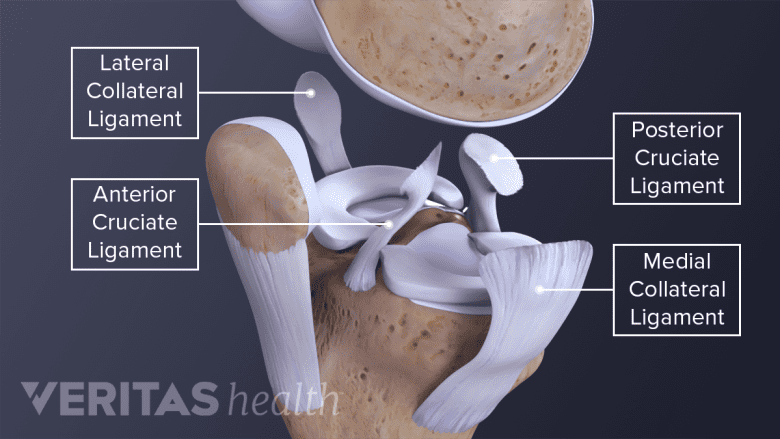A common knee injury among athletes, a knee sprain occurs when a ligament within the knee is stretched or torn. Knee sprain risk is especially high during activities that involve weight-bearing while bending or twisting such as soccer.
Knee ligaments are tough, pliable bands of soft tissue that surround and run through the knee joint to connect the femur (thighbone) and tibia (shin bone). This interconnection is essential to balance and mobility.
See Soft Tissue of the Knee Joint
A knee sprain is diagnosed and treated according to which ligament has been affected and the severity of the injury
In This Article:
Knee Ligaments That Can Be Sprained

Knee ligaments are resilient bands connecting the thighbone (femur) and shinbone (tibia) within the knee joint.
The four main ligaments of the knee are the:
- Posterior cruciate ligament (PCL)
- Anterior cruciate ligament (ACL)
- Medial collateral ligament (MCL)
- Lateral collateral ligament (LCL)
Knee Sprain Grading

Knee sprains can range greatly in severity, and are usually graded according to the following scale.
Grade I. These sprains involve only a small amount of stretching or fraying of the ligament’s fibers. The person may experience mild swelling, pain, or bruising, but can still put weight on the affected leg. On average, grade I sprains require the least amount of time to heal.1Roach. CJ e. The epidemiology of medial collateral ligament sprains in young athletes. PubMed - NCBI. Ncbinlmnihgov. 2015. Available at: http://www.ncbi.nlm.nih.gov/pubmed/24603529. Accessed August 18, 2015.
Grade II. A grade II sprain classification means that the injured ligament is partially torn. If weight is put on the affected leg, the knee may feel unstable and painful.
Grade III. The most severe sprain classification, a grade III sprain involves a complete tear of a ligament. In some cases, the ligament may separate from the bone. Swelling and bruising may be severe and it may be difficult or impossible to put weight on the affected leg.
A person who sprains a knee and continues putting pressure on it and/or playing a sport risks further joint damage. To minimize risk of further injury, an athlete with a suspected knee sprain should use the R.I.C.E. formula (rest, icing, compression, and elevation) and seek a medical evaluation.
- 1 Roach. CJ e. The epidemiology of medial collateral ligament sprains in young athletes. PubMed - NCBI. Ncbinlmnihgov. 2015. Available at: http://www.ncbi.nlm.nih.gov/pubmed/24603529. Accessed August 18, 2015.

